
UPDATE: A new interactive monitor reveals alarming gaps in Australia’s electric vehicle (EV) charging network, raising urgent concerns about the transition to clean transport. While urban areas enjoy easy access to chargers, regional Australians face significant barriers, with many towns lacking essential infrastructure.
The monitor, which pulls live data from the Open Charge Map, shows that only about one-third of towns in Australia have a charger within 20 kilometers. The situation is even more dire at closer distances, with more than two-thirds of towns lacking a charger within 5 kilometers. This stark disparity threatens the viability of EV travel across the vast Australian landscape, particularly for long-distance road trips.
Nationally, Australia boasts approximately 1,250 public charging sites with nearly 3,800 charge ports. However, the majority of these are concentrated in urban areas, leaving vast regions without adequate access. In fact, across Australia, there are only about one to two chargers for every 10,000 people, highlighting the urgent need for expansion in rural areas.
The monitor’s insights are critical as travel routes between major cities like Melbourne and Darwin reveal stretches of hundreds of kilometers without a single fast charger. These are the so-called “charging deserts,” where geographical and economic challenges hinder investment in EV infrastructure.
A growing concern is the reliability of existing chargers. While the monitor provides real-time updates on charger status, many sites are reported to be either slow or offline. Currently, there are no national standards in Australia for charger uptime, unlike in countries such as the United Kingdom, which mandates at least 99% uptime for rapid public charging networks.
The lack of consistent data reporting complicates the situation further. While a 98% reliability target exists for chargers built with federal funding, the rest operate under voluntary guidelines, creating an inconsistent and potentially unreliable network for users.
As the EV market grows, the Australian government is urged to take decisive action. Countries like New Zealand and the United States have established regulations requiring charger installations every 75 kilometers and 50 miles, respectively. In contrast, Australia falls short, with many areas lacking fast chargers for hundreds of kilometers.
The immediate next steps involve expanding charger coverage on regional routes and establishing national standards for reliability and reporting. Initiatives such as Queensland’s Electric Super Highway and New South Wales’ regional charging rollout are already underway, but a unified national strategy is essential to ensure that every major route is practical for EV travel.
Community support is also crucial. Many small towns may struggle to attract private investment until there is a clear demand for charging stations. Co-funding through state or federal grants could bridge this gap, particularly in areas reliant on tourism. A single fast charger can catalyze economic benefits for local businesses as travelers stop to charge.
The message is clear: Australia must move swiftly to address these disparities in charging infrastructure. The future of clean transport depends not only on the number of chargers but also on their strategic placement and reliability. As the nation pushes towards a greener future, it is imperative to prioritize the installation of chargers where they will have the greatest impact on both consumer confidence and environmental goals.





